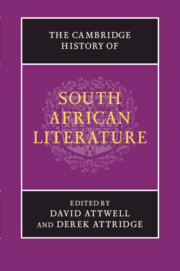Book contents
- Frontmatter
- Introduction
- PART I ORATURES, ORAL HISTORIES, ORIGINS
- 1 ‘The Bushmen's Letters’: |Xam narratives of the Bleek and Lloyd Collection and their afterlives
- 2 A contextual analysis of Xhosa iimbongi and their izibongo
- 3 ‘I sing of the woes of my travels’: the lifela of Lesotho
- 4 Praise, politics, performance: from Zulu izibongo to the Zionists
- 5 IsiNdebele, siSwati, Northern Sotho, Tshivenda and Xitsonga oral culture
- PART II EXPLORATION, EARLY MODERNITY AND ENLIGHTENMENT AT THE CAPE, 1488–1820
- PART III EMPIRE, RESISTANCE AND NATIONAL BEGINNINGS, 1820–1910
- PART IV MODERNISM AND TRANSNATIONAL CULTURE, 1910–1948
- PART V APARTHEID AND ITS AFTERMATH, 1948 TO THE PRESENT
- PART VI SOUTH AFRICAN LITERATURE: CONTINUITIES AND CONTRASTS
- Index
- References
1 - ‘The Bushmen's Letters’: |Xam narratives of the Bleek and Lloyd Collection and their afterlives
from PART I - ORATURES, ORAL HISTORIES, ORIGINS
Published online by Cambridge University Press: 28 January 2012
- Frontmatter
- Introduction
- PART I ORATURES, ORAL HISTORIES, ORIGINS
- 1 ‘The Bushmen's Letters’: |Xam narratives of the Bleek and Lloyd Collection and their afterlives
- 2 A contextual analysis of Xhosa iimbongi and their izibongo
- 3 ‘I sing of the woes of my travels’: the lifela of Lesotho
- 4 Praise, politics, performance: from Zulu izibongo to the Zionists
- 5 IsiNdebele, siSwati, Northern Sotho, Tshivenda and Xitsonga oral culture
- PART II EXPLORATION, EARLY MODERNITY AND ENLIGHTENMENT AT THE CAPE, 1488–1820
- PART III EMPIRE, RESISTANCE AND NATIONAL BEGINNINGS, 1820–1910
- PART IV MODERNISM AND TRANSNATIONAL CULTURE, 1910–1948
- PART V APARTHEID AND ITS AFTERMATH, 1948 TO THE PRESENT
- PART VI SOUTH AFRICAN LITERATURE: CONTINUITIES AND CONTRASTS
- Index
- References
Summary
In the special collections of the University of Cape Town library are over 150 notebooks filled with columns of Victorian handwriting: phonetic notations of the languages once spoken by southern Africa's |Xam and !Kung peoples with English translations alongside that run to some 13,000 pages. The record of a unique instance of cross-cultural interaction within the history of the Cape Colony, the Bleek and Lloyd Collection is widely considered to be one of the world's richest ethnographic archives, and the most important textual record of indigenous oral expression on the subcontinent. Indicative of the symbolic charge this particular culture has come to assume in contemporary South Africa, the national coat of arms unveiled by President Thabo Mbeki on 27 April 2000 carries as its motto a sentence written in |Xam, preserving the nineteenth-century orthography of the notebooks to record its various clicks. !ke e:|xarra ∥ke is officially translated as ‘Unity in Diversity’; glossed more carefully from a language no longer spoken by any living South African, it can be rendered as ‘people who are different come together’.
The disparate assemblage of texts, correspondence, photographs, watercolour sketches and other material traces that make up the collection resulted from the convergence of two very different groupings of people in late nineteenth-century Cape Town.
- Type
- Chapter
- Information
- The Cambridge History of South African Literature , pp. 15 - 41Publisher: Cambridge University PressPrint publication year: 2012

